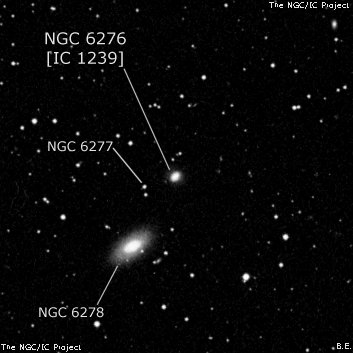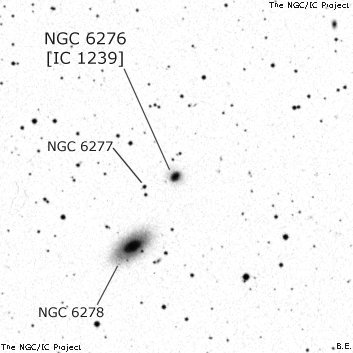NGC/IC Project Restoration Effort
(This is a very very beta version)
NGC6276


Basic Information
Location and Magnitude
Right Ascension: 17:0:45.0
Declination: +23:2:40
Constellation: HER
Visual Magnitude: 14.6
Historic Information
Discoverer: Marth
Year of discovery: 1864
Discovery aperture: 48.0
Observational
Summary description: eF
Sub-type: S0
Corwin's Notes
=====
NGC 6276 = IC 1239, NGC 6277 (a star), and NGC 6278. William Herschel found
one galaxy here. It, NGC 6278, as one might expect, is the brightest of the
group. Sixty years later, Albert Marth found two other nebulous objects near
Herschel's object. Shortly thereafter, Stephan also discovered two nebulous
objects, and also included Herschel's object in his list, correcting
Herschel's inaccurate position. However, Stephan did not mention Marth's two
objects; I don't know if he was aware of Marth's list or not.
Dreyer, faced with this rather confusing array of five positions, asked to see
Marth's observing records. These apparently did not reach Dreyer until after
the NGC had gone to press, as he added a note "in press" to the NGC that
Stephan had seen only one of Marth's objects. The positions are close enough
that Dreyer was able to correctly identify the object (NGC 6276) as m328.
m327 is north preceding about three arcminutes, and was missed by Stephan. In
the NGC note, Dreyer added that the missing object should have been inserted
in the NGC immediately following NGC 6275. Dreyer indeed added it later to
the first Index Catalogue as IC 1238.
But when we turn to the sky, there are only two galaxies here bright enough to
have been seen by the visual observers (a third, later catalogued as UGC
10650, has too low a surface brightness to have been picked up). The
brightest is obviously NGC 6278, but what is the other? Fortunately,
Stephan's micrometric position is pretty good, being off only by the amount
that his comparison star's catalogued position is off (about half an
arcminute). This correctly identifies the second galaxy as NGC 6276. If we
then correct Stephan's position for NGC 6277 for the comparison star's offset,
we find that this object is in fact a star. Assuming that Marth's two
positions are in good relative agreement, we can pin down IC 1238 as a double
star.
The confusion crept into Bigourdan's observations, too. He correctly
identified NGC 6278, but misidentified a star as NGC 6277, and actually
published NGC 6276 as a "nova" in his second list of new nebulae. He later
realized his mistake, and correctly equated the NGC object with his "nova"
(which had by then received the number IC 1239) in his final published list of
observations. His observation of "NGC 6277" is interesting in that there is
a faint galaxy just a few arcseconds north-following the star he measured.
Did he perhaps glimpse the galaxy, but then measure the brighter star?
Sulentic, with three NGC numbers in hand, and with three relatively large
galaxies in sight on the Sky Survey, misidentifies UGC 10650 as RNGC 6276, and
assigns the number RNGC 6277 to NGC 6276. NGC 6278's correct identification
survived even into the RNGC.
Steve's Notes
=====
NGC 6276
17.5": very faint, small, round. Forms a pair with NGC 6278 2.3' SE. Two faint mag 14.5/15 stars are 2' E. The northern of these two stars is NGC 6277.



